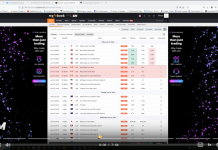 On Friday 2nd February 2018, the US Department of Labour released data regarding January’s Non-Farm Payrolls, unemployment rate and average hourly earnings. These data releases are important because analysts are able to use them to get a clear picture of the US labour market. The unemployment rate remained unchanged at 4.1%, which is the lowest reading in the last 17 years. Non-farm Payrolls is also one of the most important data releases coming from the US each month.
On Friday 2nd February 2018, the US Department of Labour released data regarding January’s Non-Farm Payrolls, unemployment rate and average hourly earnings. These data releases are important because analysts are able to use them to get a clear picture of the US labour market. The unemployment rate remained unchanged at 4.1%, which is the lowest reading in the last 17 years. Non-farm Payrolls is also one of the most important data releases coming from the US each month.
What are Non-Farm Payrolls?
Non-Farm Payrolls represent the number of new jobs created in the past month, in all non-agricultural business. The number of new farm employees is excluded because of the seasonality in farm jobs. Non-Farm Payrolls data is considered a key economic indicator because it includes almost 80% of the US total workforce.
Non-Farm Payrolls survey results
The report showed that approximately 200,000 new jobs were added to the US economy during January 2018, some 20,000 more than what market analysts had been expecting. In December 2017, Non-Farm Payrolls had disappointed markets. The survey, published on the 5th January by the US Department of Labour, showed that only 148,000 jobs were added to the economy.
The report noted that, during January 2018, employment continued to trend up in construction, food services and drinking places, health care and manufacturing. Employment in other major industries such as retail and wholesale trade, transportation and housing, professional business services, changed little over the month. Average hourly earnings on an annualised basis were a positive surprise as they increased by 2.9%, hitting a 9-year high.
 STO is a broker regulated by FCA and CySEC. It offers more than 300 financial instruments such as Forex, Indices, Oil, Stocks, Commodities and Bonds. STO clients have possibility to trade thanks to reliable MT4 and AFX FAST platforms. Check STO offer!
STO is a broker regulated by FCA and CySEC. It offers more than 300 financial instruments such as Forex, Indices, Oil, Stocks, Commodities and Bonds. STO clients have possibility to trade thanks to reliable MT4 and AFX FAST platforms. Check STO offer!
How Non-Farm Payrolls data can affect the market?
During 2017, the US economy was adding, on average, 171,000 new jobs per month, down from the average 187,000 in 2016 and 226,000 recorded in 2015. The declining number of the Non-Farm Payrolls in the last three years shows that the labour market has tightened considerably as the US economy seems to be getting back on track of growth.
The Non-Farm Payrolls monthly report is regarded as one of the most important data releases because economists and market analysts are using it in order to have a clear picture of how much the US economy is growing on a monthly basis. The report is also taken into consideration by the Federal Open Market Committee, during its interest rate setting meetings, and plays a role in its decisions.
Economists that follow developments in the US economy forecast that the current pace of job growth could bring the unemployment rate down to 3.5% by the end of 2018. The tightening of the labour market and an average earnings’ increase could force the Federal Reserve to hike its benchmark interest rate, leading to the US Dollar’s appreciation. Currently, the majority of economists expect that the Federal Open Market Committee will increase interest rates in its March 2018 meeting.
A positive Non-Farm Payrolls report can strengthen the US Dollar against its major competitors such as the Euro (USD/EUR), the British Pound (USD/GBP) and the Japanese Yen (USD/JPY). On the contrary, when the report misses expectations, a decline in the US Dollar’s value could be expected. The US currency’s value dropped immediately after December’s 2017 Non-Farm Payrolls report was published, leading to a US Dollar sell-off.
Gold as a commodity can be also affected in the same way, depending on the results of the Non-Farm Payrolls report. An upside surprise in the report can trigger the US Dollar’s strengthening against rival currencies and attract investors that see gold as a safe haven when major currencies depreciate. A negative report, which could weaken the US Dollar, could be beneficial for the price of gold in global markets.
Stock market indexes can be also affected by the release of the Non-Farm Payrolls report. A strong result, which could make the US Dollar edge up against the Euro, the British Pound and the Japanese Yen, could make stock market indexes drop. Positive labour market reports such as Non-Farm Payrolls in the US may indicate future interest rate hikes by Central Banks. In that case, investors may prefer the fixed income investments than equities. If the Non-Farm Payrolls report disappoints, there is a possibility that stock market indexes will climb.
Trading Forex and CFDs, which are leveraged products, are high risk investments and puts your capital at risk. You may sustain a loss of some or all of your invested capital. Only speculate with money you can afford to lose

















